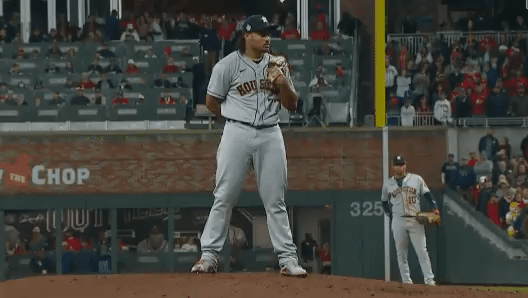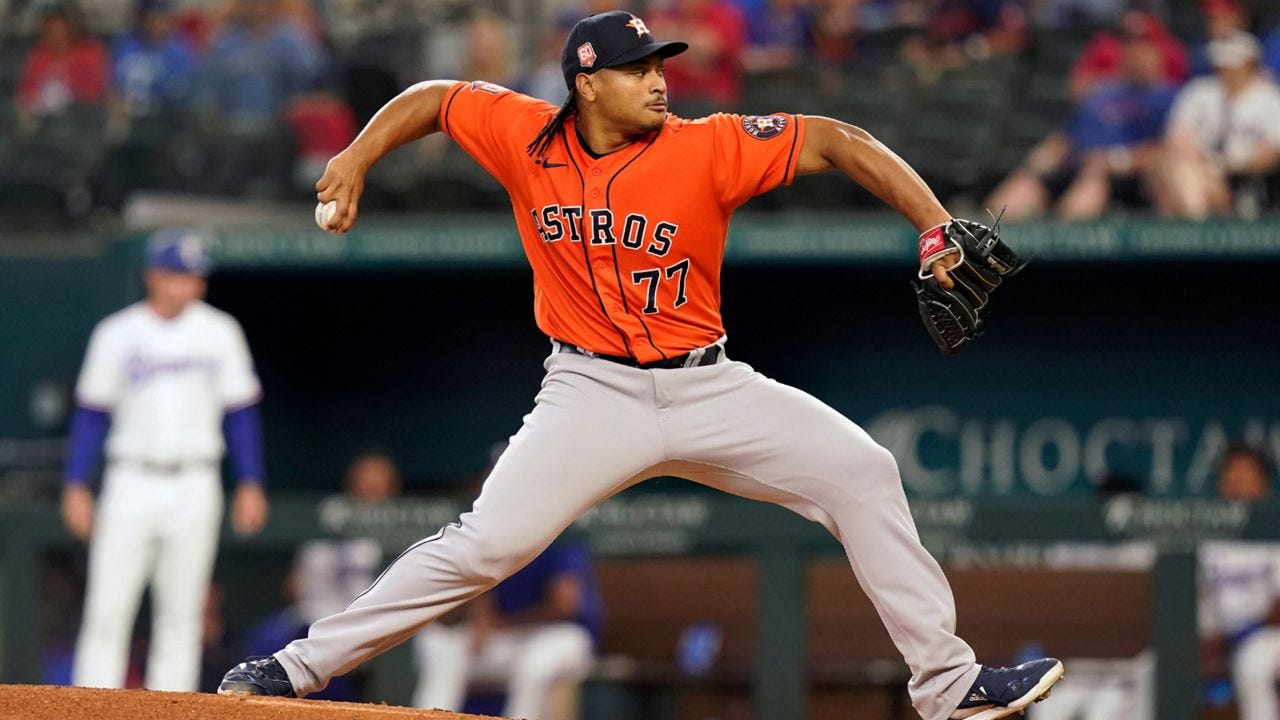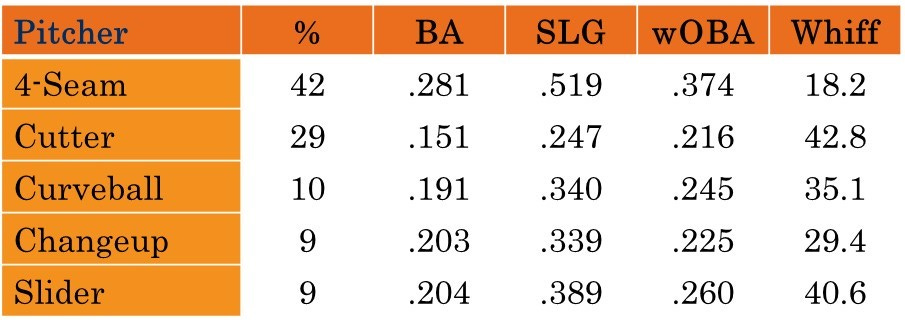Luis Garcia Must Get a New Windup. What He Really Needs is a Better Fastball.
Much Attention Has Already Been Given How Rules Enforcement Will Compel Luis Garcia to Change His Windup. I'm Going to Focus on Whether He Can Improve His Mediocre Fastball.
Luis Garcia will make his Spring Training debut this afternoon when the Astros take on the Mets. But even before he has thrown a Grapefruit League pitch, Luis Garcia became the center of attention. As pitchers and catchers reported to camp, Major League Baseball announced that it was cracking down this year on illegal pitches. And who was the poster boy for these pitches—Luis Garcia.


MLB rules say that in the windup, a pitcher can take one step forward and then one step backwards. It’s actually always been illegal to do the cha-cha on the mound like Garcia does. But umpires had been letting it slide. Apparently, no more.
This has led to lots of focus on Garcia this Spring Training. Including what Chandler Rome described as “the most videoed bullpen session in spring training history.” How had Garcia changed his windup? We still don’t know because Garcia threw from the stretch.
No, seriously, all his pitches were from the stretch.
But I was able to make one important conclusion from this set of Twitter videos—the position of the reporters. Chandler was furthest to the right. Tags was on the left, and Mark Berman was in the middle of the group.
Despite all the attention on the need for Garcia to change his windup, it’s not clear to me that change will be all that big of a deal for Garcia. After all, Garcia pitches from the stretch frequently without a windup and seems to do quite fine from there.
In a locker room session with reporters this Spring, Garcia was asked if it is “hard to do to change what you’ve been doing for a long time.” “No,” Garcia replied, “I mean it’s normal.”
And in one sense, changing his windup is definitely normal. Garcia did not grow up with the rock-the-baby delivery. Jake Kaplan, the former Astros beat writer for The Athletic, wrote on how the Astros scouted Garcia back in 2021 and included a video from a throwing session Garcia did before scouts in Venezuela in an effort to get signed.
This video was memorable to me for a clear reason—Garcia was not doing the cha-cha in his windup. I had assumed he had developed the windup style playing on the Venezuelan equivalent of a sandlot as a kid. No, he had changed it as a professional player.
So the focus on Garcia’s windup may be overblown. Heck, he throws from the stretch plenty.
But I would argue that the focus on Garcia himself in 2023 is not. With the departure of Justin Verlander, Garcia became a more important cog in the Astros starting rotation—and on track to be part of the playoff rotation (all his playoff appearances in 2022 were out of the bullpen). The injury to Lance McCullers only drives home Garcia’s importance.
If Garcia can improve on his 2022 performance, then the Astros can more easily absorb the loss of Verlander and any injury issues from McCullers or any other starting pitcher. But the question is whether he can improve.
Luis Garcia: Model of Consistency
Garcia has been a member of the Astros starting rotation for two full seasons now and has been reliable at taking the ball every turn in the rotation. He started 28 games in both seasons and threw essentially the same number of innings both seasons (155.1 in 2021; 157.1 in 2022).
And Garcia has not just been reliable, but he has been very consistent. Opponents slashed .232/.295/.393 against Garcia in 2021; .222/.279/.399 in 2022). Garcia’s strikeout rate declined modestly from 26.4% in 2021 to 24.4% in 2022, but his walk rate declined as well from 7.9% to 7.3%. But them together and Garcia’s strikeout to walk ratio has stayed exactly the same—it was 3.34 in both of his full seasons in the majors.
These numbers show that Garcia has a high floor as a pitcher. He has delivered above average performances for two straight seasons. But Garcia’s consistent performances also raise the question of whether he can improve in 2023. To do that, Garcia will need to improve his 4-seam fastball.

One Ineffective Pitch; Four Effective Ones
Garcia’s biggest weakness is his 4-seam fastball. The table below shows that opponents hit .281 against Garcia’s fastball in 2022 with a .519 slugging percentage. Only 18.2% of the time does he get a swing and a miss when throwing this pitch. Yikes!
It is notable how much better Garcia is when he throws one of his four other pitches. His best pitch is his cutter, which has a .151 batting average against, a .247 slugging percentage against, and gets whiffs 42.8 of the time.
But Garcia’s other secondary offerings are quite effective as well. He throws his curveball and changeup against left handed hitters. His slider is reserved for righties.
You can get a full sense of the range in effectiveness of these pitches by looking at the wOBA column. Against Garcia’s 4-seam fastball, the average major leaguer hits like Mookie Betts or Rafael Devers, who both had a .373 wOBA in 2022. Against the rest of Garcia’s pitches, the average major leaguer hits worse than Martin Maldonado (.264 wOBA).
It’s common for pitchers to have stronger results against secondary pitches than their fastball, but the spread for Garcia is much larger than average.
Garcia’s fastball has relatively little horizontal movement. It has 0.8 inches more movement than the average major league fastball, which means it has less natural “run” than pitchers such as Justin Verlander. Garcia does have a high spin fastball, but he does not get as much “ride” as Cristian Javier. Thus, it does not stay above bats the way that Javier’s fastball does.
The result is that opponents can get their barrel of their bat to Garcia more often than is ideal. Opponents hit barreled balls 5.3% of the time in 2022, which was squarely in the middle of major league starters. Of the 102 starters who allowed over 350 “batted ball events,” Garcia ranked 51st.
Garcia ranked 34th among the same set of pitchers in hard hit percentage. Garcia is capable of managing contact, but when the opponent can get a hold of one, they can send it a long way.
Can Garcia Improve His Fastball?
So the big question for Luis Garcia in 2023 is not how he can adjust his windup. He’s done that before and I expect that he will be able to do it again.
The question is can he improve his four-seam fastball. The pitch has relatively little movement and was hammered last season. What can Garcia do to improve it.
Obviously, one suggestion that the has become common in the MLB in recent years is to throw your best pitches more and your worse pitches less, if at all. Garcia followed this prescription some in 2022, dropping his share of four-seamers from 45% to 42%. He may drop its usage more in 2023.
But it is difficult to drop one’s fastball entirely. The fastball sets up the other pitches, providing a contrast for Garcia’s cutter, slider, curve, and changeup. And a fastball is the pitch one can rely on to get a strike when needed.
So it is hard to envision that Garcia can dump his four-seam fastball entirely. The issue becomes how he can make it better. Because if he does, he has shown that opponents cannot hit his other pitches well.
A better fastball will produce a better Luis Garcia.






